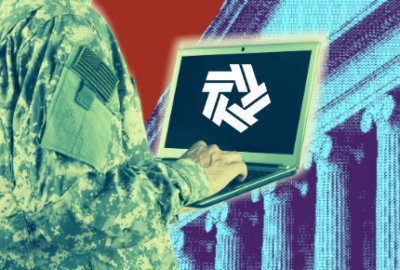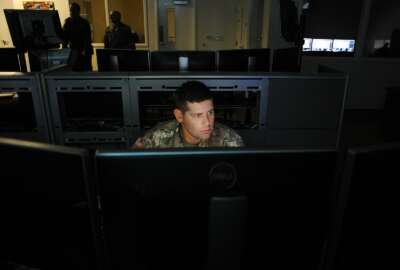A progress report on JADC2 from the contracting side
Joint All-Domain Command and Control is the Defense Department's project, known as JADC2, aims for a single enterprise network to which all of the armed service...
Best listening experience is on Chrome, Firefox or Safari. Subscribe to Federal Drive’s daily audio interviews on Apple Podcasts or PodcastOne.
Joint All-Domain Command and Control is the Defense Department’s project, known as JADC2, aims for a single enterprise network to which all of the armed services can plug in. For a progress report from the contractor point of view, at the SeaAirSpace conference, Federal Drive with Tom Temin caught up with the chief technology officer at Northrop Grumman Scott Stapp.
Interview transcript:
Scott Stapp: When we look at JADC2 holistically, we look at it as essentially the internet of warfighting things, what has transpired on the internet, where from your cell phone, you can command and control your entire life off every aspect of it, from medical to finance, to entertainment to travel. I think the government is looking at the same thing. What they’re looking at right now is how do you do that in the most effective fashion, because you can’t conquer everything at once and tie it together. So they’re looking at what are the most effective things to tie together to start with, and show how that improves warfighting effectiveness and improves your kill chain opportunities.
Tom Temin: Because Admiral Gilday said that they’ve had a third spiral, they’re not satisfied with where they are yet on all of this. But ye,t it’s not a contractualized program, really, as we understand it in building anything yet.
Scott Stapp: Right. So I think in a lot of ways, you’re going to look at these as more exercise opportunities. So there’s one that was done recently that was literally just last week. And it was part of IBCS, which is Integrated Air and Missile Defense Battle Command System from the Army. And normally that is a patriot battery system with a bunch of Sentinel radars or Patriot radars. What they did is they tied in Marine Corps radar called Gator, and an F-35 radar. And they actually fired a missile not using any of their organic assets, they use external assets. That had never been done before. And they do a shoot down. So I think those exercises start looking at what that data flow looks like, what that opportunity looks like, by integrating external capabilities.
Tom Temin: Got it. So it’s almost like controlling your thermostat from your phone when you’re out for dinner or something like that.
Scott Stapp: Well, and I think you’ll see it grow up the same way when you first had your phone, it really was a flip phone, it was just a phone. And then you started tying in other capabilities where you could text, and then it started allowing you to access your bank account. But the concept of Uber are Waze wouldn’t have even existed just 10 years ago. So as you start to connect things and more data is available, that opportunity space also grows.
Tom Temin: And I imagine they must have bandwidth and reliability and all of those issues basic to any network to be able to enable all of that in a way that they can do what they want to do functionally.
Scott Stapp: Absolutely true. So, what you see back in the old 3G days was you couldn’t do a lot of data, right? You needed to the 4G network to come in. The DoD is going to have the same issue. COM’s and networking are always going to be the limitations when you want to start integrating everything together. So where we are today is very similar to where I would say Apple was with the iPod, you actually plugged it in, downloaded it, left, went somewhere, but you couldn’t update it, and then at some point when the network is available, you get data. iPods are almost non existent anymore, and you can do real-time updates on your phone. I think the DoD is looking at the same thing. We’re more in that iPod state where you download a mission profile, you download a threat profile, you fly out, you fly back, and nothing’s changed. As we increase our COM’s and networking capabilities, it’ll be much more real-time warfighting capabilities.
Tom Temin: Got it. So from a, say a Northrop Grumman standpoint, then it’s a function of systems integration and programming, but not really invention of new technology here.
Scott Stapp: I would say that’s absolutely true. I think there are going to be some new technologies. There’s some AIML — artificial intelligence machine learning capabilities. As we look at data, especially as it applies to the Department of Defense, I think there’s going to be some COM’s and networking because you can’t do it all through what has been commercially done in 4G, and now 5G. So there will be some new technologies, but I don’t think any of them are huge obstacles. I think most of it, right now to JADC2, is really more cultural, how you integrate everybody together and getting them on the same sheet of music.
Tom Temin: Yes, because beyond that concept, you’ve had each armed services member will have its own rendition of this operation overmatch and so forth for the Navy. And so somehow they have to use standards, or open standards, I would imagine, such that eventually all the armed services will be interoperable on this JADC2.
Scott Stapp: So what you definitely want is you want open standards and open architectures. They may not come up with the same exact capabilities. And I think this is where defense industry actually plays a huge role, which is, which each defense prime contractor actually plays across all services. And this is where combining the role of JADC2 and CTO really help. So as we do something for the Army, or the Navy, or the Air Force, or the Marines, we can invest IRAD [Independent Research and Development] dollars to ensure when they want to connect, we’ve made it available so they can connect, we don’t leave them in isolation. So I think industry can play that role of some somewhat of an integrator with the services.
Tom Temin: Yeah, in some sense, you can probably give them a better picture than they can get themselves of what’s going on in the other service. Because you programmed it, or built it.
Scott Stapp: I think that’s very true.
Tom Temin: And so in some ways, this is a, I go back to when they disconnected AUTODIN, and then we had WiMAX. If I’m really dating myself, this is kind of that for the 21st century and 5G.
Scott Stapp: I think it is, in fact, another good example is when you had the PC wars, and they kind of settled into kind of, basically Microsoft PC’s and Apple. Originally, you couldn’t share files between those two,
Tom Temin: I remember those days.
Scott Stapp: Right? Where people liked a Microsoft, basically platform, but not the PC, they loved the Apple PC. But now, today, they make it seamless where you can actually share across. We’re gonna get into those environments.
Tom Temin: So it’s really a fundamental shift to an architecture, and the components will come and go, but the basic architecture should be durable.
Scott Stapp: Absolutely. So what you’ll see is, is very similar to commercial, you can’t buy a phone, a tablet, a computer, anywhere in the world that doesn’t plug into the internet. So when the DoD comes up with an architecture, they should not be developing platforms, whether they’re space, air, land, sea, undersea, that doesn’t automatically plug into the network.
Tom Temin: And again, looking at it from the industry standpoint, how do they do this in such a way that it can’t be easily duplicated by enemies, that type of capability?
Scott Stapp: Well, I think our adversaries are looking at doing very similar things. What they recognize is when you’re operating in what they classify as a highly contested environment you can’t get in, you do you have to integrate things from space and other realms. The question is how effectively you can do it, you still need end items, right? So very similar to the internet, you still need TV’s, and you need speakers and other things. The end items still need to be very capable. By making them data centric, you make them more capable.
Tom Temin: You still need kinetic things that blow up and kill the other guy.
Scott Stapp: Well, we don’t, but…
Tom Temin: They do, sure.
Scott Stapp: You need you need capabilities that increase their effectiveness by giving them more data and interaction in the architecture.
Tom Temin: And are you hearing signals that they want to remain vendor independent, or at least not have vendor lock in, as they move forward with the operational components down the line?
Scott Stapp: One hundred percent for sure. So one of the agreements, basically not agreement, one of the statements we’ve made from our CEO level all the way through the company is no one should own the data, or the network except for the U.S. government. What we should do is be able to plug in and play, and make our platforms more effective. By doing that, we should be able to develop software capabilities where they can process and use the data more effectively. But the data and the network need to be government owned. It needs to be open architected.
Tom Temin: And so would it be fair to characterize industry at this point as simply watching what’s going on?
Scott Stapp: No, no. I wouldn’t say we’re just watching, but I will tell you, I think, again, JADC2, and you put it really good, JADC2 is really not a destination, it’s a journey. And they’re a little bit at the beginning of this journey, so we have to take our cues from the DoD, but we’re actively pursuing capabilities and looking at how you integrate different, especially within within our company at Northrop Grumman, how you integrate those capabilities, how we play with partners from other primes to ensure they’re integrated in because we can’t make it just about ourselves, and how we tie all that stuff together. So we’re actively doing that on IRAD. We’re working with the government to look at what the next opportunities are and what are the best warfighting capabilities to tie together and then pushing from there.
Tom Temin: Scott Stapp is Chief Technology Officer at Northrop Grumman, speaking at the Navy League’s SeaAirSpace Conference.
Copyright © 2024 Federal News Network. All rights reserved. This website is not intended for users located within the European Economic Area.
Tom Temin is host of the Federal Drive and has been providing insight on federal technology and management issues for more than 30 years.
Follow @tteminWFED







